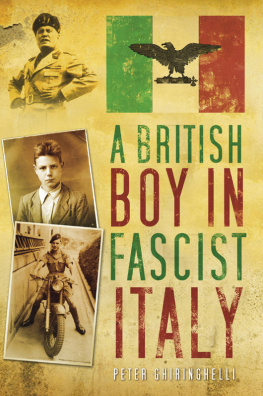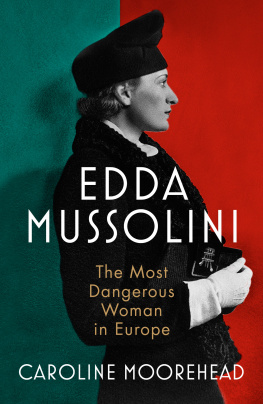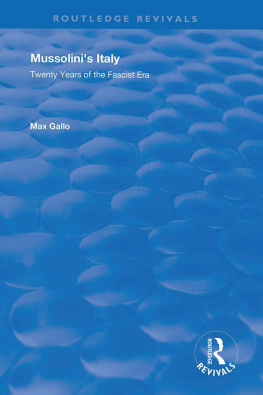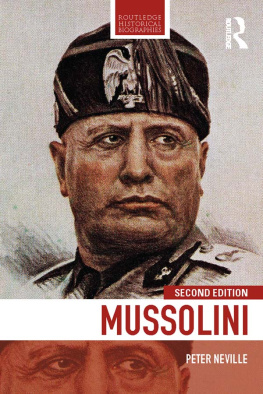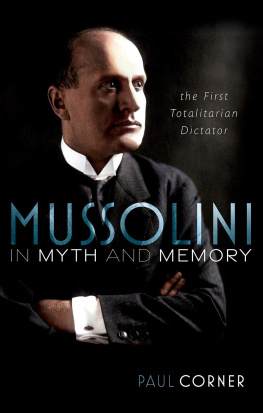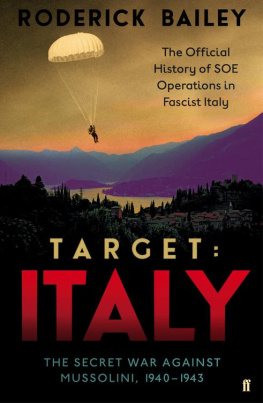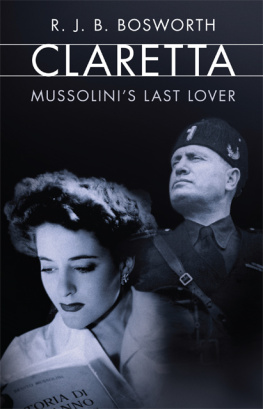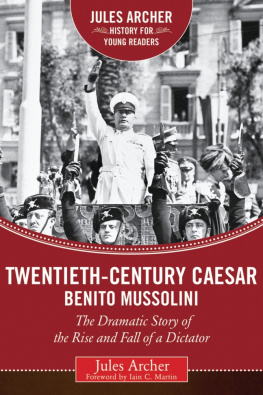A BRITISH
BOY IN
FASCIST
ITALY
A BRITISH
BOY IN
FASCIST
ITALY
PETER GHIRINGHELLI

Cover illustrations. Front, top, left: Benito Mussolini (London Illustrated News); top, right: flag of the RSI; middle: authors ID card photo, 1944; bottom: author in Hong Kong, 1952. Back: Italian immigrants from Manchester and Leeds, 1910.
First published 2010
The History Press
The Mill, Brimscombe Port
Stroud, Gloucestershire, GL5 2QG
www.thehistorypress.co.uk
This ebook edition first published in 2013
All rights reserved
Peter Ghiringhelli, 2010, 2013
The right of Peter Ghiringhelli to be identified as the Author of this work has been asserted in accordance with the Copyright, Designs and Patents Act 1988.
This ebook is copyright material and must not be copied, reproduced, transferred, distributed, leased, licensed or publicly performed or used in any way except as specifically permitted in writing by the publishers, as allowed under the terms and conditions under which it was purchased or as strictly permitted by applicable copyright law. Any unauthorised distribution or use of this text may be a direct infringement of the authors and publishers rights, and those responsible may be liable in law accordingly.
EPUB ISBN 978 0 7524 9677 1
Original typesetting by The History Press
CONTENTS
ABBREVIATIONS
British |
ARP | Air Raid Precautions |
HMS | His Majestys Ship |
ILH-KR | Imperial Light Horse and Kimberley Regiment |
Lt-Cdr | Lieutenant Commander |
SS | Steamship (as prefix to ships names) |
Italian |
Anti-fascist: |
CLN | Comitato di Liberazione Nazionale (Committee for National Liberation) |
CLNAI | Comitato di Liberazione Nazionale per lAlta Italia (Committee for National Liberation for Northern Italy) |
GAP | Gruppi di Azione Patriotica (Patriotic Action Groups) |
PSI | Partito Socialista Italiana (Italian Socialist Party) |
Fascist: |
ENR | Esercito Nazionale Republicano (National Republican Army) |
GIL | Giovent Italiana del Littorio (Italian Fascist Youth Movement) |
GNR | Guardia Nazionale Republicana (Republican National Guard) |
MVSN | Milizia Volontaria per la Sicurezza Nazionale (National Militia for National Security) |
ONB | Opera Nazionale Balilla (Italian Fascist Youth Movement) |
RSI | Republica Sociale Italiana (Italian Social Republic) |
X-MAS | Decima Flottiglia Motoscafi Antisommergibili (Tenth Anti-Submarine Torpedo Boats Squadron) |
rastrellamento | Literally a raking, but used to describe anti-partisan operations and searches carried out by Republican Fascist and German forces |
German |
KdS | Kommandure Sipo-SD |
(SD Regional Command) |
SD | Sicherheitsdienst (Security Service) |
SS | Schutzstaffel (Elite Guard) |
SS-Aussenposten | SS Forward Commands |
SS-Oberstgruppenfhrer | SS Colonel-General |
SS-Gruppenfhrer | SS Lieutenant-General |
SS-Hauptsturmfhrer | SS Captain |
SS-Sturmbannfhrer | SS Major |
SS-Scharfhrer | SS Sergeant |
SS-Rottenfhrer | SS Corporal |
INTRODUCTION
M ore than an introduction, I think a word of explanation is required. Between June 2003 and January 2006, the BBC asked the public to contribute their stories of World War Two to a website called WW2 Peoples War. The submitted material, amounting to 47,000 articles and 15,000 images, is now permanently archived.
In November 2003, after several prompts from my wife Margaret, I decided to submit my story under the title A Childhood in Nazi-occupied Italy. The limit for submitted contributions was 2,000 words and I condensed my story to fit that limit. Then in late 2008 Sophie Bradshaw, a commissioning editor for The History Press, having read my account, contacted me and suggested that I should expand it for publication. This book is the result.
I kept no diaries in Italy, nor did I subsequently write anything down, so all is based on my memory. The problem, of course, is that human memory is fallible. I wrote my story for WW2 Peoples War exactly as I remembered it, but afterwards when I came to consult others, especially those in Italy, I found that I had often been mistaken in dating events. Unfortunately, it is not possible now to access my original BBC account to correct it. Wherever there is a discrepancy between the two versions, the one given here, based on detailed research, is the more accurate.
Throughout the book, Fascist (spelt with a capital F) refers to members of the Italian Fascist Party, and Partisan (with a capital P) refers to a member of an Italian Partisan Group, otherwise I have used lowercase. Where fascist and partisan appear in cited official documents, I have retained the original lowercase.
I should like to thank my dear friend Clara Fortunelli in Vicenza for tracking down obscure books in Vicenzas public library and scanning pages for me; also Roberto Rivolta, a boyhood friend, now living in Luino on Lake Maggiore, for reminding me of events and shared experiences and sending me photos; and Pancrazio De Micheli in Porto Valtravaglia for giving me permission to publish photos of years gone by, which have appeared in a series of yearly calendars of the Valtravaglia, for which he is the co-ordinator; and finally Margaret, my wife, who has been a great help in patiently reading and correcting the manuscript.
PRE-WAR DAYS IN LEEDS
F or many decades after the Second World War, those who had lived through the war divided time and their lives into two distinct periods, always known as before the war and after the war. Before the war is a half-forgotten age, a different world, a dim and distant past. Leeds before the war was a black city, literally; all its stone buildings were black with decades of grime and soot, typical of a northern industrial city, before the post-war Clean Air Act was introduced and the many splendid Victorian municipal buildings sand-blasted clean. Gas lamps were everywhere and gas lamp lighters still made their rounds carrying lamp-post ladders; known as knocker-uppers, they also knocked on bedroom windows to wake people up for work in the mills and factories. There were no pedestrianised areas or one-way traffic systems then; it was a city of clanking trams, solid-tyred lorries, many cars, but even more bicycles and horse-drawn carts, and the roads had many water troughs for horses to drink from. Order started to be made of the traffic chaos in 1934 with the introduction of the Transport Secretary Leslie Hore-Belishas pedestrian crossings, with glass orange lights which inevitably became known as Belisha Beacons, the forerunners of post-war zebra crossings. Life in Leeds seemed to be regulated by factory whistles and sirens, especially at five and six oclock, when thousands of factory workers poured out onto the streets on foot and on bicycles, and long queues formed at tram stops.
Next page
